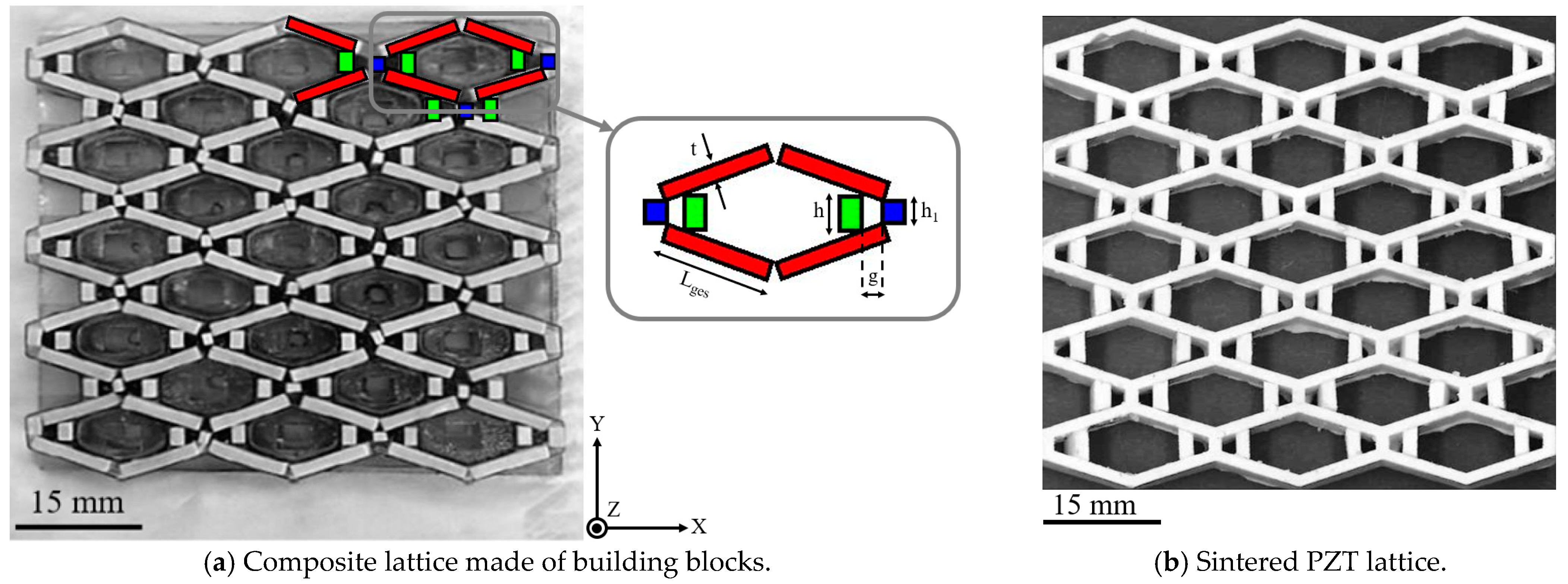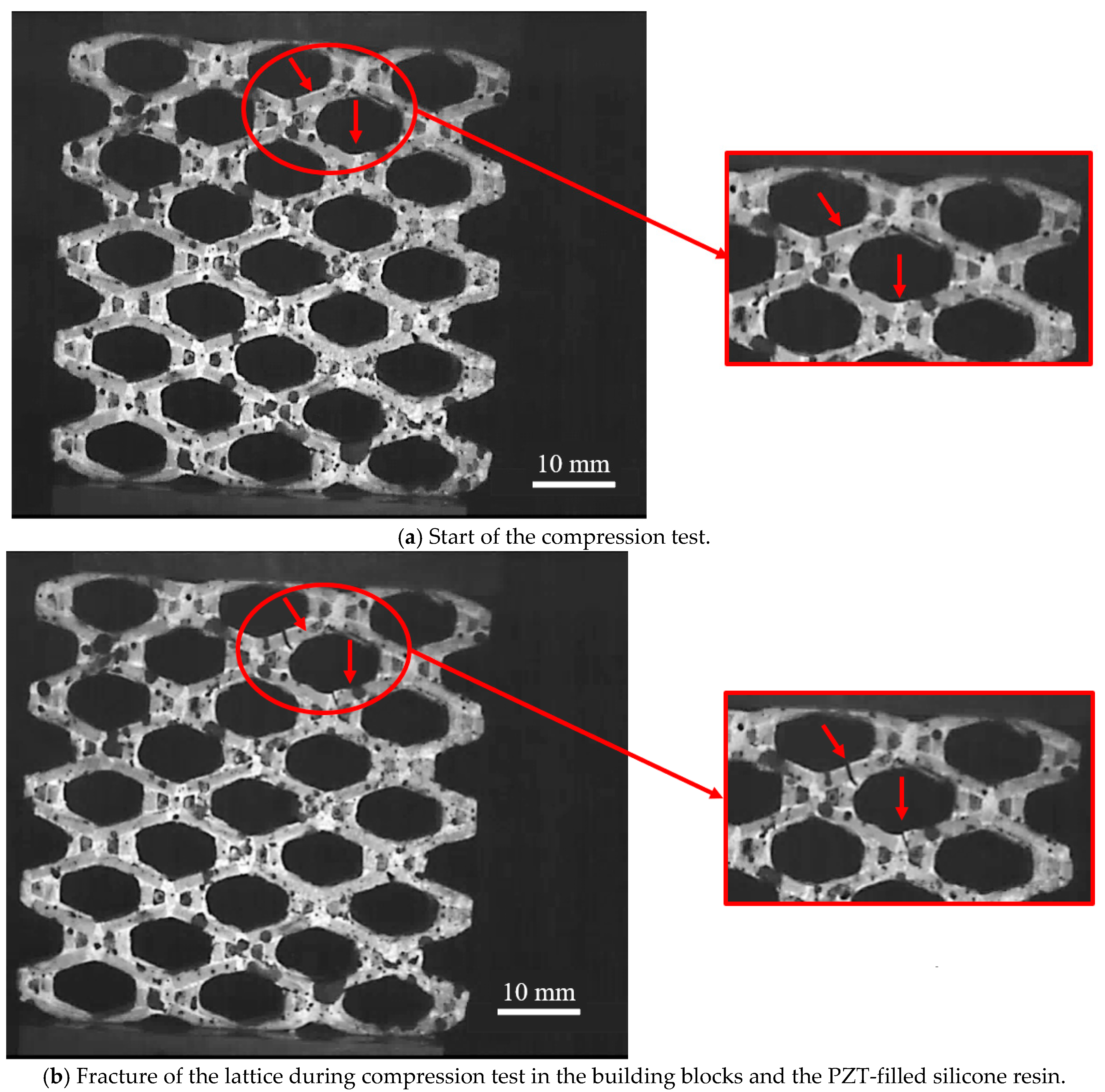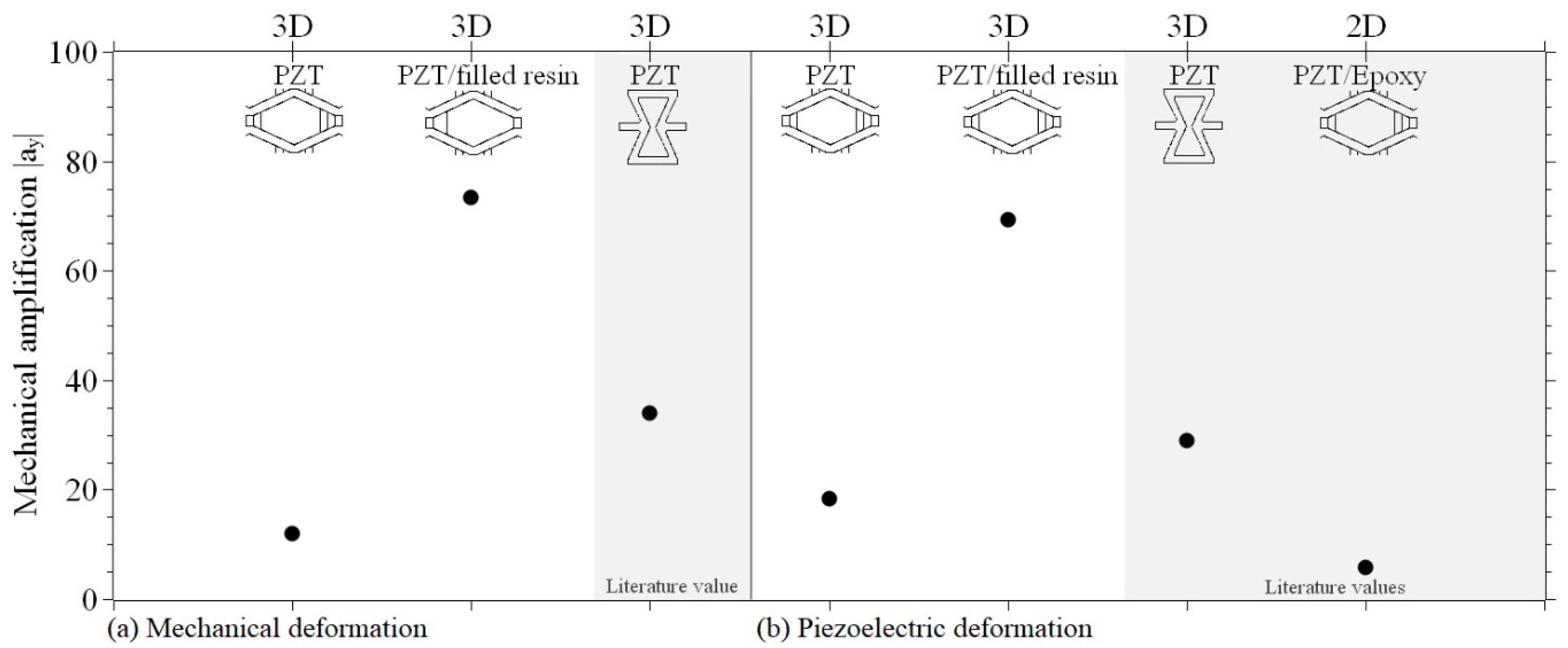Improved Mechanical Amplification of Monolithic PZT and PZT Composite via Optimized Honeycomb Macrostructures
Abstract
1. Introduction
2. Materials and Methods
2.1. Sample Production
2.2. Characterization
3. Results and Discussion
3.1. Structure Analysis
3.2. Mechanical Amplification
3.3. Piezoelectric Strain Response
4. Conclusions
Supplementary Materials
Author Contributions
Funding
Institutional Review Board Statement
Informed Consent Statement
Data Availability Statement
Conflicts of Interest
References
- Malek, S.; Gibson, L.J. Effective elastic properties of periodic hexagonal honeycombs. Mech. Mater. 2015, 91, 226–240. [Google Scholar] [CrossRef]
- Fey, T.; Eichhorn, F.; Han, G.; Ebert, K.; Wegener, M.; Roosen, A.; Kakimoto, K.; Greil, P. Mechanical and electrical strain response of a piezoelectric auxetic PZT lattice structure. Smart Mater. Struct. 2016, 25, 15017. [Google Scholar] [CrossRef]
- Iyer, S.; Venkatesh, T.A. Electromechanical response of (3–0) porous piezoelectric materials: Effects of porosity shape. J. Appl. Phys. 2011, 110, 34109. [Google Scholar] [CrossRef]
- Iyer, S.; Venkatesh, T.A. Electromechanical response of porous piezoelectric materials: Effects of porosity connectivity. Appl. Phys. Lett. 2010, 97, 072904. [Google Scholar] [CrossRef]
- Iyer, S.; Alkhader, M.; Venkatesh, T.A.; Landis, C. Electromechanical Response of Piezoelectric Honeycomb Foam Structures. J. Am. Ceram. Soc. 2014, 97, 826–834. [Google Scholar] [CrossRef]
- Challagulla, K.S.; Venkatesh, T.A. Electromechanical response of piezoelectric foams. Acta Mater. 2012, 60, 2111–2127. [Google Scholar] [CrossRef]
- Li, T.; Wang, L. Bending behavior of sandwich composite structures with tunable 3D-printed core materials. Compos. Struct. 2017, 175, 46–57. [Google Scholar] [CrossRef]
- Schaedler, T.A.; Carter, W.B. Architected Cellular Materials. Annu. Rev. Mater. Res. 2016, 46, 187–210. [Google Scholar] [CrossRef]
- Nielsen, L.F. Composite Materials: Properties as Influenced by Phase Geometry; Springer: Berlin, Germany, 2005. [Google Scholar]
- Safari, A.; Allahverdi, M.; Akdogan, E.K. Solid freeform fabrication of piezoelectric sensors and actuators. J. Mater. Sci. 2006, 41, 177–198. [Google Scholar] [CrossRef]
- Alderson, K.L.; Alderson, A.; Grima, J.N.; Wojciechowski, K.W. Auxetic Materials and Related Systems. Phys. Status Solidi B 2014, 251, 263–266. [Google Scholar] [CrossRef]
- Hassan, M.R.; Scarpa, F.; Mohammed, N.A.; Ancrenaz, Y. Conventional and Auxetic SMA Cellular Structures. In Proceedings of the ASME 2005 International Mechanical Engineering Congress and Exposition, Aerospace, Orlando, FL, USA, 5–11 November 2005; pp. 451–456. [Google Scholar] [CrossRef]
- Muraoka, M.; Sanada, S. Displacement amplifier for piezoelectric actuator based on honeycomb link mechanism. Sens. Actuator A Phys. 2010, 157, 84–90. [Google Scholar] [CrossRef]
- Iyer, S.; Alkhader, M.; Venkatesh, T.A. On the relationships between cellular structure, deformation modes and electromechanical properties of piezoelectric cellular solids. Int. J. Solids Struct. 2016, 80, 73–83. [Google Scholar] [CrossRef]
- Eichhorn, F.; Keppner, F.; Köllner, D.; Fey, T. Deformation Behavior of 2D Composite Cellular Lattices of Ceramic Building Blocks and Epoxy Resin. Adv. Eng. Mater. 2021, 24, 2100536. [Google Scholar] [CrossRef]
- Eichhorn, F.; Schiegerl, H.; Köllner, D.; Kakimoto, K.; Fey, T. Stress and Deformation Behavior of 2D Composite Cellular Actuator Structures of Ceramic Building Blocks and Epoxy Resin. Phys. Status Solidi B Basic Res. 2022, 259, 2100591. [Google Scholar] [CrossRef]
- Wallace, A.S. Optimizing Electromechanical Coupling in Piezocomposites Using Polymers with Negative Poisson’s Ratio. In Proceedings of the Ultrasonics Symposium, Orlando, FL, USA, 8–10 December 1991; pp. 661–666. [Google Scholar]
- Evans, K.E. The Design of Doubly Curved Sandwich Panels with Honeycomb Cores. Compos. Struct. 1991, 17, 95–111. [Google Scholar] [CrossRef]
- Thill, C.; Ethches, J.; Bond, I.; Potter, K.; Weave, P. Morphing skins. CEAS Aeronaut. J. 2008, 112, 117–139. [Google Scholar] [CrossRef]
- Eichhorn, F.; Kellermann, S.; Betke, U.; Fey, T. Phase Evolution, Filler-Matrix Interactions, and Piezoelectric Properties in Lead Zirconate Titanate (PZT)-Filled Polymer-Derived Ceramics (PDCs). J. Mater. 2020, 13, 1520. [Google Scholar] [CrossRef]
- Greil, P. Active Filler Controlled Pyrolysis of Preceramic Polymers (AFCOP). J. Am. Ceram. Soc. 2005, 78, 835. [Google Scholar] [CrossRef]
- Biggemann, J.; Köllner, D.; Simon, S.; Heik, P.; Hoffmann, P.; Fey, T. Porous Functional Graded Bioceramics with Integrated Interface Textures. Ceramics 2021, 4, 681–695. [Google Scholar] [CrossRef]
- Biggemann, J.; Müller, P.; Köllner, D.; Simon, S.; Hoffmann, P.; Heik, P.; Lee, J.H.; Fey, T. Hierarchical Surface Texturing of Hydroxyapatite Ceramics: Influence on the Adhesive Bonding Strength of Polymeric Polycaprolactone. J. Funct. Biomater. 2020, 11, 73. [Google Scholar] [CrossRef]
- Ceron-Nicolat, B.; Wolff, F.; Dakkouri-Baldauf, A.; Fey, T.; Münstedt, H.; Greil, P. Graded cellular ceramics from continuous foam extrusion. Adv. Eng. Mater. 2012, 22, 1097–1103. [Google Scholar] [CrossRef]
- Sobhani, S.; Allan, S.; Muhunthan, P.; Boigne, E.; Ihme, M. Additive Manufacturing of tailored microporous ceramic structures for high-temperature applications. Adv. Eng. Mater. 2020, 22, 2000158. [Google Scholar] [CrossRef]
- Vijayavenkataraman, S.; Kuan, Y.L.; Lu, W.F. 3D-printed ceramic triply periodic minimal surface structures for design of functionally graded bone implants. Mater. Des. 2020, 191, 108602. [Google Scholar] [CrossRef]
- Zeschky, J.; Höfner, T.; Arnold, C.; Weißmann, R.; Bahloul-Hourlier, D.; Scheffler, M.; Greil, P. Polysilesquioxane deried ceramic foams with gradient porosity. Acta Mater. 2005, 53, 927–937. [Google Scholar] [CrossRef]
- Lee, H.; Jang, T.-S.; Song, J.; Kim, H.-E.; Jung, H.-D. The production of porous hydroxyapatite scaffolds with graded porosity by sequential freeze-casting. J. Mater. 2017, 10, 367. [Google Scholar] [CrossRef] [PubMed]
- Lindner, M.; Bergmann, C.; Telle, R.; Fischer, H. Calcium phosphate scaffolds mimicking the gradient architecture of native long bones. J. Biomed. Mater. Res. Part A 2014, 102, 3677–3684. [Google Scholar] [CrossRef]
- Wang, Q.; Wang, Q.; Wan, C. Preparation and evaluation of a biomimetic scaffold with porosity gradients in vitro. An. Acad. Bras. Ciênc. 2012, 84, 9–16. [Google Scholar] [CrossRef]
- Werner, J.; Linner-Krěmar, B.; Friess, W.; Greil, P. Mechanical properties and in vitro cell compatibility of hydroxyapatite ceramics with graded pore structure. Biomaterials 2002, 23, 4285–4294. [Google Scholar] [CrossRef]
- Naat, N.; Boutar, Y.; Naïmi, S.; Mezlini, S.; da Silva, L.F.M. Effect of surface texture on the mechanical performance of bonded joints: A review. J. Adhes. 2021, 2008370, 1–93. [Google Scholar] [CrossRef]
- Eichhorn, F.; Keppner, F.; Köllner, D.; Fey, T. Deformation Behavior of 2D Composite Cellular Lattices of Ceramic Building Blocks and Epoxy Resin. Adv. Eng. Mater. 2022, 24, 2270004. [Google Scholar] [CrossRef]
- Stumpf, M.; Fan, X.; Biggemann, J.; Greil, P.; Fey, T. Topological interlocking and damage mechanisms in periodic Ti2AlC-Al building block composites. J. Eur. Ceram. Soc. 2019, 39, 2003–2009. [Google Scholar] [CrossRef]
- Götz, M. Modulare Keramik-Komposite mit Periodischer Mikrostruktur. Ph.D. Thesis, Friedrich-Alexander Universität Erlangen, Erlangen, Germany, June 2014. [Google Scholar]
- Fey, T.; Götz, M.; Greil, P. Photoelastic imaging of residual stress distribution in epoxy interface layers of ceramics with periodic building-block structure. Adv. Eng. Mater. 2013, 15, 1099–1104. [Google Scholar] [CrossRef]
- Sharma, S.K.; Gaur, H.; Kulkarni, M.; Patil, G.; Bhattacharya, B.; Sharma, A. PZT–PDMS composite for active damping of vibrations. Compos. Sci. Technol. 2013, 77, 42–51. [Google Scholar] [CrossRef]
- Furukawa, T.; Fujino, K.; Fukada, E. Electromechanical Properties in the Composites of Epoxy Resin and PZT Ceramics. Jpn. J. Appl. Phys. 1976, 15, 2119–2129. [Google Scholar] [CrossRef]
- Pan, B.; Qian, K.; Xie, H.; Asundi, A. Two-dimensional digital image correlation for in-plane displacement and strain measurement: A review. Meas. Sci. Technol. 2009, 20, 62001. [Google Scholar] [CrossRef]
- McBain, J.W.; Hopkins, D.G. On adhesives and adhesive. J. Phys. Chem. A 1925, 29, 88. [Google Scholar]
- Rudawska, A. Surface Treatment in Bonding Technology, 1st ed.; Academic Press: London, UK, 2019. [Google Scholar]
- Ebnesajjad, S. Adhesives Technology Handbook, 2nd ed.; William Andrew: Norwich, NY, USA, 2008. [Google Scholar]
- Prolongo, S.G.; Rosario, G.; Ureña, A. Study of the Effect of Substrate Roughness on Adhesive Joints by SEM Image Analysis. J. Adhes. Sci. Technol. 2006, 20, 457–470. [Google Scholar] [CrossRef]
- Sykes, J.M. Surface Treatment for Steel. In Surface Analysis and Pretreatment of Plastics and Metals; Brewis, D.M., Ed.; Applied Science Publishers Limited: London, UK, 1982; pp. 153–174. [Google Scholar]




| Material Unit | True Density g cm−3 | Geom. Density g cm−3 | Porosity vol% |
|---|---|---|---|
| Bulk PZT | 7.94 | 7.47 | 5.92 |
| Filled silicone resin | 3.27 | 3.17 | 3.00 |
| Composite material as PZT Building Blocks plus PZT-filled silicone resin | 6.74 | 6.36 |
| Material | Relative Permittivity | Piezoelectric Coupling Coefficients | Mechanical Amplification According Supplementary Equation (S5) | |||||||||
|---|---|---|---|---|---|---|---|---|---|---|---|---|
| εr | d31 | d32 | d33 | |axpiezo| | |aypiezo| | |||||||
| % | pC N−1 | % | pC N−1 | % | pC N−1 | % | % | % | ||||
| Bulk PZT | 1195 ± 30 | −140.00 ± 3 | −140.00 ± 3 | 325.00 ± 23 | 1 | 1 | ||||||
| PZT lattice | 709 ± 62 | −40.7 | −1296.80 ± 40 | +826.3 | −2571.80 ± 39 | +1737.0 | 320.00 ± 15 | −1.5 | 9.30 | +830.0 | 18.40 | +1740.0 |
| PZT-filled silicone resin | 2.87 ± 0.05 | −99.8 | −0.08 ± 0.003 | −99.9 | −0.08 ± 0.003 | −99.9 | 0.31 ± 0.05 | −99.9 | ||||
| Composite lattice | 74 ± 23 | −93.8 | −2120.10 ± 160 | +1414.3 | −2650.20 ± 216 | +1793.0 | 37.00 ± 6.6 | −88.6 | 29.00 | +2800.0 | 69.40 | +6840.0 |
| Auxetic PZT lattice [2] | −4240.00 | +2928.6 | −4060.00 | +2800.0 | 400.00 | 0.0 | 30.30 | +2930.0 | 29.00 | +2800.0 | ||
Publisher’s Note: MDPI stays neutral with regard to jurisdictional claims in published maps and institutional affiliations. |
© 2022 by the authors. Licensee MDPI, Basel, Switzerland. This article is an open access article distributed under the terms and conditions of the Creative Commons Attribution (CC BY) license (https://creativecommons.org/licenses/by/4.0/).
Share and Cite
Eichhorn, F.; Bytomski, J.; Gerauer, M.; Kakimoto, K.-i.; Fey, T. Improved Mechanical Amplification of Monolithic PZT and PZT Composite via Optimized Honeycomb Macrostructures. Materials 2022, 15, 7893. https://doi.org/10.3390/ma15227893
Eichhorn F, Bytomski J, Gerauer M, Kakimoto K-i, Fey T. Improved Mechanical Amplification of Monolithic PZT and PZT Composite via Optimized Honeycomb Macrostructures. Materials. 2022; 15(22):7893. https://doi.org/10.3390/ma15227893
Chicago/Turabian StyleEichhorn, Franziska, Julia Bytomski, Markus Gerauer, Ken-ichi Kakimoto, and Tobias Fey. 2022. "Improved Mechanical Amplification of Monolithic PZT and PZT Composite via Optimized Honeycomb Macrostructures" Materials 15, no. 22: 7893. https://doi.org/10.3390/ma15227893
APA StyleEichhorn, F., Bytomski, J., Gerauer, M., Kakimoto, K.-i., & Fey, T. (2022). Improved Mechanical Amplification of Monolithic PZT and PZT Composite via Optimized Honeycomb Macrostructures. Materials, 15(22), 7893. https://doi.org/10.3390/ma15227893







